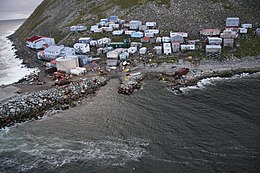|
Little Diomede Island
Little Diomede Island or Yesterday Island (Inupiaq: Iŋaliq, formerly known as Krusenstern Island,[a][3] Russian: остров Крузенштерна, romanized: ostrov Kruzenshterna) is an inhabited island of Alaska. It is the smaller of the two Diomede Islands located in the Bering Strait between the Alaskan mainland and Siberia. The island has one town, also called Diomede. EtymologyThe Diomede Islands are named after Saint Diomedes. The Inupiaq name Iŋaliq means "the other one" or "the one over there".[4] The two islands are respectively nicknamed "Yesterday Island" (Little Diomede Island) and "Tomorrow Island" (Big Diomede Island) because the International Date Line runs between them, making the date on Little Diomede Island always one day later than the date on Big Diomede Island.  GeographyLittle Diomede Island is located about 16 miles (25 km) west of mainland Alaska, in the middle of the Bering Strait. It is only 0.4 miles (0.6 km) from the International Date Line and about 2.4 miles (3.9 km) from the Russian island of Big Diomede. According to the United States Census Bureau, the island has a total area of 2.8 sq mi (7.3 km2), all of it land. On the western shore of the island is the village of Diomede, also known as Iŋaliq. The highest point on Little Diomede Island is 1,621 feet (494 m) (about halfway along the west coast, about 1.5 miles (2.4 km) south-east of the village, facing the southern tip of Big Diomede). The island has very scant vegetation. Big Diomede Island, located 2.33 miles (3.75 km) west of Little Diomede Island, is part of Russia. Thus the two islands are separated by an international boundary. The International Date Line also runs between the two islands. GeologyLittle Diomede island is composed of Cretaceous age granite or quartz monzonite.[5][6] The location of the settlement is the only area which does not have near-vertical cliffs to the water. Behind the settlement, and around the entire island, rocky slopes rise at about 40° up to the relatively flattened top in 1,148–1,191 ft (350–363 m). Important Bird AreaThe island, along with its surrounding waters, has been designated an Important Bird Area (IBA) by BirdLife International because of its significant seabird colonies, including those of black-legged kittiwakes, and of parakeet, least and crested auklets.[7] ClimateSummer temperatures average 40 to 50 °F (4 to 10 °C). Winter temperatures average from 6 to 10 °F (−14 to −12 °C). Annual precipitation averages 10 inches (250 mm), and annual snowfall averages 30 inches (76 cm). During summer months, cloudy skies and fog prevail. Winds blow consistently from the north, averaging 15 knots (17 mph; 28 km/h), with gusts of 60 to 80 miles per hour (97–129 km/h). The Bering Strait is generally frozen between mid-December and mid-June.[2]  DemographyAs of 2021, the town of Diomede had a population of 82, down from its recorded peak of 208 in 1998.[1][8] All the land on Little Diomede Island is officially within the town of Diomede (which, like the island as a whole, is also called Iŋaliq).[2] The island is not part of any organized borough, so some services that are normally provided to Alaskan towns by boroughs are instead provided to it directly by the state. For census purposes, it is included in the Nome Census Area. HistoryDanish-Russian navigator Vitus Bering (after whom the Bering Strait is named) sighted the Diomede Islands on August 16 (O.S., August 27 N.S.), 1728, the day on which the Russian Orthodox Church celebrates the memory of Diomedes of Tarsus.[9] During the Cold War, the section of the border between the USA and the USSR that separates Big and Little Diomede became known as the "Ice Curtain". Despite this nickname implying chilly relations, when Lynne Cox swam from Little Diomede to Big Diomede (about 2.2 miles (3.5 km)) in August 1987, she was congratulated jointly by Mikhail Gorbachev and Ronald Reagan.[10] AccessThere is a heliport, the Diomede Heliport, with regular helicopter flights. In the past, locals carved a runway into the thick ice sheet so that bush planes could deliver vital products, such as medicine and grocery supplies. Due to annual variations of the ice sheet, the runway would change position every year. However, climate change has meant that sea ice has neither been thick nor stable enough to support landing a plane safely on an ice runway (minimum required sea-ice thickness was 4.5 feet, and no open water to the north of the island), so the last Bering Air flight landed there in May 2013 and there has not been an ice runway since.[11][12] In popular cultureLittle Diomede was featured in the first episode of Full Circle with Michael Palin, a 1997 BBC documentary series in which the broadcaster Michael Palin traversed many of the countries of the Pacific Rim.[13] The Diomede Islands are also featured in the novel Further Tales of the City, by Armistead Maupin, and the miniseries based on the book. In addition, Alexander Armstrong visited the island as part of his 2015 series Land of the Midnight Sun. Little Diomede was also featured in the 1952 film Arctic Flight, starring Wayne Morris and Lola Albright. See alsoExplanatory notes
References
External linksWikivoyage has a travel guide for Little Diomede. |
||||||||||||||||||||||||||||||||||||

